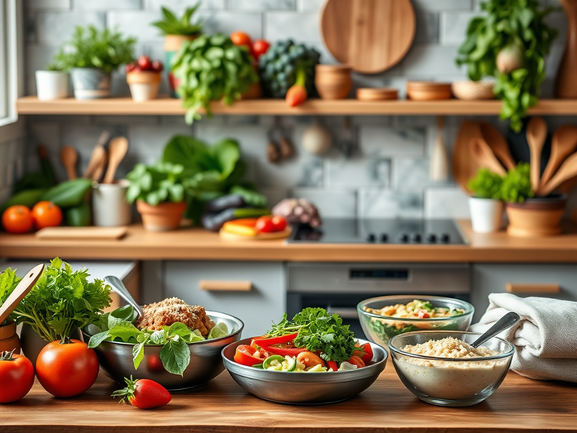Pantry Essentials on a Pennies-a-Plate Budget: Stock Your Plant-Powered Toolkit
Building a plant-powered pantry on a shoestring budget might sound like a tall order, but with a bit of strategy and a handful of nutrient-dense staples, you can transform every meal into an affordable yet satisfying feast. The secret lies in focusing on ingredients that offer the highest nutritional bang for the buck, stretch across multiple culinary uses, and store beautifully for weeks or even months.
At the core of budget-friendly vegan cooking are beans and lentils. These humble legumes deliver protein, fiber, iron, and complex carbohydrates at mere pennies per serving. Imagine a steaming bowl of black beans simmered in smoky chipotle and cumin one night, then spun into tacos the next, and finally swirled into a creamy bean soup midweek. That kind of versatility is what Forks Over Knives champions as the cornerstone of smart meal prep. Buying dried beans in bulk not only slashes cost per cup, it means you can cook once and enjoy leftovers all week long, freeing up precious time when life gets hectic.
Whole grains also pull more weight than you might expect. A big bag of brown rice, oats, barley, or quinoa becomes the foundation for everything from hearty porridge to savory grain bowls. Oats soak up flavors overnight, transforming into an effortless breakfast paired with cinnamon, fruit, or a spoonful of nut butter. Barley doesn’t just make soup heartier—it soaks up broth until it rivals risotto in creaminess, minus the sticker shock of restaurant prices. I often cook extra grains on Sunday so I can grab-and-go during hectic weekdays, saving both time and money every morning—an idea supported by Plant Based on a Budget.
Beyond beans and grains, a few other staples round out your budget-savvy pantry toolkit. Stock up on frozen vegetables such as peas, corn, and mixed stir-fry blends; they’re usually cheaper than fresh and freeze-lock nutrients at peak ripeness. Pantry spices like garlic powder, cumin, chili flakes, smoked paprika, and dried herbs allow you to transform bland rice or beans into dishes that sing with flavor. A small jar of nutritional yeast can mimic cheesy richness in sauces or popcorn, while a bottle of soy or tamari boosts umami in marinades and stir-fries.
To make these staples truly sing, consider creating flavor bases that can be frozen in cubes: blitz roasted red peppers with garlic and oil for a quick sauce, or puree cilantro and jalapeño with lime for instant taco seasoning. These little flavor bombs cost almost nothing to freeze, but they elevate weekday dinners from “meh” to memorable.
Below is a simple table illustrating the core staples, their nutritional highlights, and approximate cost per cooked cup when purchased in bulk. While prices vary by region, this gives a rough idea of how inexpensive plant-power can be.
| Staple | Key Nutrients | Approximate Cost per Cooked Cup* |
|---|---|---|
| Black Beans (dried) | Protein, Fiber, Iron | $0.15 |
| Brown Rice | Complex Carbs, B Vitamins, Magnesium | $0.10 |
| Lentils (green or brown) | Protein, Fiber, Folate | $0.12 |
| Rolled Oats | Fiber, B Vitamins, Phosphorus | $0.08 |
| Frozen Mixed Veggies | Vitamins A & C, Potassium | $0.20 |
| Nutritional Yeast | Vitamin B12, Protein | $0.30 |
*Prices are estimates and will vary by store and region.
Finally, don’t underestimate the power of water quality. Beans and grains cooked in clean, filtered water taste noticeably brighter and more vibrant. Learn how reverse osmosis filtration works here. With these foundational staples in your pantry, you’ll find that eating plant-based on a budget isn’t just possible—it’s downright delicious.
Budget-Smart Meal Planning: Crafting a Week of Flavorful, Low-Cost Vegan Menus
Meal planning can often feel like a chore, but with an eye on affordability and a dash of creativity, you can map out a week’s worth of plant-based meals that excite your palate and keep your wallet happy. The key is building your menu around the most wallet-friendly ingredients—beans, whole grains, potatoes—and then layering in seasonal produce, spices, and simple sauces to keep things interesting.
Start by selecting your protein and carb anchors. Bulk brown rice, lentils, chickpeas, and oats should dominate your shopping list because they offer maximum nutrition at minimal cost. Once those are in your cart, fill in with fresh or frozen veggies, seasonal fruit, and pantry basics such as canned tomatoes, soy sauce, and a bottle of good olive oil. With these in hand, draft a template for breakfast, lunch, and dinner that you can customize each day.
The Cheap Lazy Vegan’s seven-day, $20 (CAD) meal-prep plan is a textbook example of how far inexpensive staples will stretch. By cooking lentils and oats in bulk, then spicing them differently for each meal, you end up with sweet porridge one morning, savory oatmeal the next, and a lentil-powered pasta sauce for dinner—all without blowing your budget (The Cheap Lazy Vegan). Similarly, the Forks Over Knives one-week vegan meal plan comes in at roughly $9 USD per day, with simple hacks like soaking chickpeas overnight and repurposing dinner leftovers for next-day lunches (Forks Over Knives).
To illustrate, here’s a sample weekly menu with rough per-meal cost estimates. This framework can be adjusted based on local prices and seasonal availability.
| Day | Breakfast | Lunch | Dinner | Approx. Daily Cost |
|---|---|---|---|---|
| Monday | Overnight oats with banana & cinnamon | Bean and rice burrito bowl | Mushroom barley risotto | $3.50 |
| Tuesday | Savory oatmeal with spinach & nutritional yeast | Chickpea salad sandwich | Sweet potato and lentil curry | $3.75 |
| Wednesday | Peanut butter banana toast | Leftover risotto with roasted veggies | Stir-fried rice and veggies | $3.25 |
| Thursday | Fruit smoothie with oats | Lentil soup with whole grain bread | Chili with black beans & cornbread | $4.00 |
| Friday | Cinnamon-apple porridge | Bean salad over greens | Tofu stir-fry with rice | $3.80 |
| Saturday | Overnight oats with mixed berries | Leftover chili tacos | Vegan “mac and cheese” with nutritional yeast sauce | $4.20 |
| Sunday | Peanut butter oatmeal | Mushroom barley risotto wrap | Homemade veggie pizza on a potato crust | $4.50 |
Notice how repurposing leftovers—risotto becomes a wrap; chili becomes taco filling—keeps costs down and flavors varied. The New Baguette’s meal prep ideas highlight that creativity with leftovers is your secret weapon against both boredom and waste (The New Baguette). Sweet Potato Soul also encourages mixing in simple recipes like Sweet Pea Mash or Mushroom Barley Risotto to break up monotony without adding cost (Sweet Potato Soul).
Finally, remember that water quality isn’t just about drinking—clean, filtered water makes soups, grains, and beans taste brighter. Discover how to keep every dish tasting its best by exploring reverse osmosis filtration. With a solid plan, a few budget-savvy hacks, and confidence in your ability to remix ingredients, a week of tasty, wallet-friendly vegan meals is well within reach.
Batch Cooking Secrets for Effortless Reheats: Save Time, Money, and Savor Every Bite
When life gets busy, the idea of cooking every night can feel overwhelming. Enter batch cooking: dedicating a couple of hours once or twice a week to prepare large quantities of grains, beans, and vegetables so that assembling meals later feels as easy as reheating and topping.
Begin by selecting budget-friendly staples: brown rice, lentils, black beans, and oats. Simmer big pots of each on a Sunday afternoon, seasoning lightly so they can be dressed up in different ways. As Plant Based on a Budget shows, a few dollars spent on dried staples yields enough base ingredients for dozens of meals Plant Based on a Budget. For instance, cooking four cups of dried beans—about twelve cups cooked—covers burritos, salads, tacos, and soups for days.
While your grains and beans gently bubble, roast a variety of seasonal or frozen vegetables tossed in oil and spices. A colorful tray of sweet potatoes, cauliflower, and carrots can become the hero of grain bowls one night, then blend into a creamy soup another. Maya from Sweet Potato Soul swears that this simple roast-and-store trick keeps taste fatigue at bay: just switch up the spices from curry powder to chili flakes, or drizzle different sauces when you plate Sweet Potato Soul.
Batch-cooked basics shine brightest when paired with quick sauces or dressings. Whip up a tahini-lemon dressing, a peanut-ginger sauce, or a tomato-garlic base and store them in jars for instant flavor boosters. As The Cheap Lazy Vegan demonstrates, a single pot of lentils simmered with onions, garlic, and tomato paste can stretch into lentil sloppy joes, pasta sauce, or lentil tacos, depending on the seasonings you add when reheating The Cheap Lazy Vegan.
Organization is key. Glass containers labeled by day and meal type help you navigate the week without rummaging through the fridge. Always rinse produce with clean water before chopping—filtered by an under-sink reverse osmosis system to remove chlorine and impurities—so your vegetables stay crisp and free of bacteria.
Below is a simple batch cooking schedule that maps out what to cook, store, and reheat. Adjust quantities based on your household size and appetite.
| Item Cooked | Prep Day | Portions Yielded | Reheat Ideas |
|---|---|---|---|
| Brown Rice | Sunday | 8 cups | Grain bowls, fried rice, stuffed peppers |
| Black Beans | Sunday | 10 cups | Tacos, bean chili, bean salad |
| Lentils in Tomato Sauce | Sunday | 6 cups | Sloppy joes, pasta sauce, grain salad |
| Roasted Vegetables | Sunday | 5 servings | Bowls, soups, wraps |
| Oats | Sunday | 7 servings | Overnight oats, baked oatmeal, smoothie thickener |
By investing just a few hours at the start of the week, you’re not only slashing cooking time each evening, you’re cutting food waste and trimming your grocery bill. Each reheated meal tastes as fresh as the day you cooked it when you include vibrant sauces and fresh garnishes like chopped herbs or a squeeze of citrus.
Batch cooking isn’t about sacrificing variety—it’s about building a flexible toolkit of ready-to-go components that you can remix into endless meals. Embrace the art of reinvention, and you’ll find yourself looking forward to leftovers as much as new creations, all while saving time, money, and energy.
Sources
- Forks Over Knives – Plant-Based Budget One-Week Vegan Meal Plan
- Osmosis Info – Understanding Reverse Osmosis Water Filtration
- Osmosis Info – Unlock Clean Drinking Water: How Reverse Osmosis Works and Its Benefits
- Osmosis Info – Under-Sink Reverse Osmosis System Basics
- Plant Based on a Budget – Home
- Sweet Potato Soul – Cheap Vegan Meal Plan
- The Cheap Lazy Vegan – 20 Vegan Meal Prep 7 Full Days
- The New Baguette – Plant-Based Meal Prep Ideas

